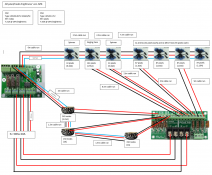JordoLights
New elf
Hello all, this is my first serious year. Last year I tried playing with 2x WS2812B 5V 5m strips using a NodeMCU just to see how I like it. I immediately got hooked to the hobby. This year, I have expanded my display more buy adding some props, arches, and outlines. I got myself a rPi-28D+ from Alan as I figured I can easily upgrade or add later on a controller with more outputs.
I have tried my best to do a wiring diagram of what my setup will be like. I need some overall tips/advice as I am fairly new to this hobby.
Everything is 5v.
My grey areas are (sorry if some of these doesn't make sense or if they are beginner questions):
1. Power injection - I've laid out in the diagram what/where I think is best to power inject? Is it true that I have to inject every 100 nodes/pixels?
2. What cable is best to use for power injection?
3. I set the brightness to 24% so it'll all be under 7.5A draw so to comply with the fuses on the 28D+ and power distribution board. What if I want to run it at 30% and the draw is >7.5A, do I just cut the + wire at 7.4A then start a fresh + from the PSU?
4. Instead of running multiple lines of power injections (ie. 2x to the arches), can I run 1 line to the arches then tap off to the 2 arches?
5. Is it necessary to fuse (2A) the rPi power input?
Thanks heaps in advance for your guidance and help.

I have tried my best to do a wiring diagram of what my setup will be like. I need some overall tips/advice as I am fairly new to this hobby.
Everything is 5v.
My grey areas are (sorry if some of these doesn't make sense or if they are beginner questions):
1. Power injection - I've laid out in the diagram what/where I think is best to power inject? Is it true that I have to inject every 100 nodes/pixels?
2. What cable is best to use for power injection?
3. I set the brightness to 24% so it'll all be under 7.5A draw so to comply with the fuses on the 28D+ and power distribution board. What if I want to run it at 30% and the draw is >7.5A, do I just cut the + wire at 7.4A then start a fresh + from the PSU?
4. Instead of running multiple lines of power injections (ie. 2x to the arches), can I run 1 line to the arches then tap off to the 2 arches?
5. Is it necessary to fuse (2A) the rPi power input?
Thanks heaps in advance for your guidance and help.


